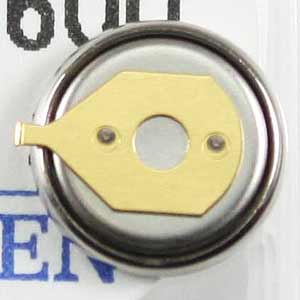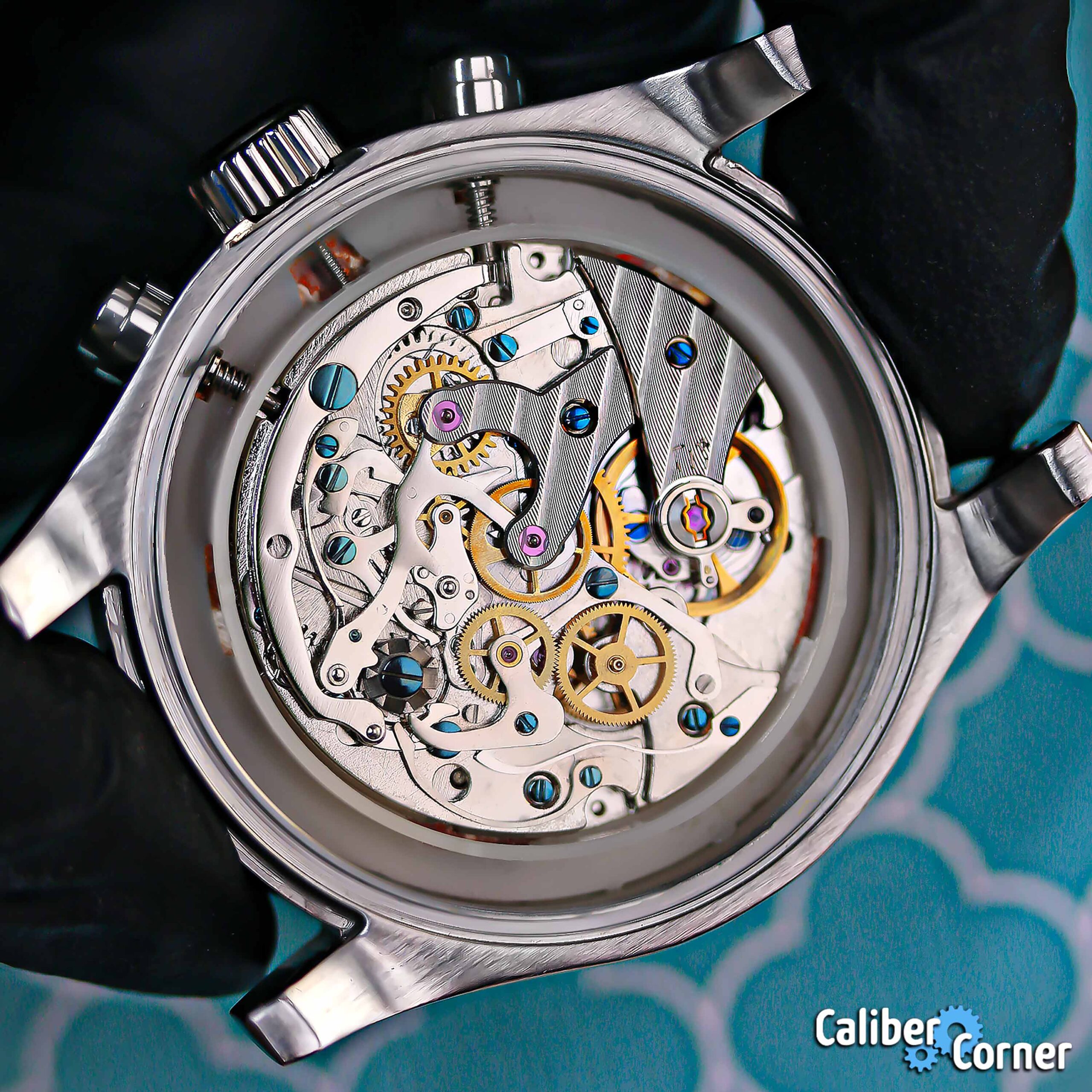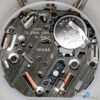Some of the topics covered in this caliber listing:
What is a Watch Capacitor or Accumulator?
Watch capacitors (also referred to as accumulators) are battery-like cells that store power in solar or kinetic watches. Unlike a mechanical watch which gets energy from a mainspring, or quartz watches that are powered by stored energy in a battery, solar watches get their energy from the sun or other light sources. Remember solar powered calculators we used in school? They would only work when under an adequate light source, and covering the small solar panel on the calculator with your finger would cut the power and shut it off. A solar powered watch is similar, except that it needs to be able to stay “on” even when the light source is unavailable (at night or when your sleeve covers the watch) in order to keep the time. This is where the capacitor comes in. The energy from the light source is transferred to the capacitor, and as it accumulates energy, it continuously powers the watch.
A kinetic watch is similar, except that instead of garnering its energy from the sun, the energy comes from a rotor that spins while on your wrist. This concept is like an automatic movement, but instead of the energy from the spinning rotor accumulating in a mainspring, it goes to the capacitor which keeps the watch powered even after you take it off at night.
The note above came on a small piece of paper from a watch parts supplier I ordered capacitors from before. Not sure which one it was, the source will be updated if found.
“Capacitor Information: Capacitors are storage devices and do not necessarily come already charged. The customer needs to charge the watch after inserting the capacitor. Seiko capacitors are charged either by oscillating motion or a Seiko Kinetic Recharger. Citizen capacitors are solar cells, using sunlight or an artificial UV light source to recharge. Capacitors should not be tested. A battery tester will not give an accurate reading. Most of the time, the capacitor itself is not defective. Sometimes the brass connector may not be attached perfectly and may be the problem. If the watch does not run after fully charging the new capacitor, do not assume the capacitor is defective. There may be an unrelated problem with the movement. Returns for capacitors are not accepted without prior authorization.” -Unknown source
How to Replace a Capacitor in a Watch?
Replacing the capacitor in a solar or kinetic watch is much like replacing the battery in a quartz watch. Typically instead of a battery strap holding the battery cell in place, there will be screws holding tabs or prongs that are welded onto the capacitor cell. There are many different styles of capacitors, so the replacement process will vary depending on the caliber in your watch.
What is MT920 or MTxxx?
Each capacitor is typically stamped with a cell number such as MT920 or CTL621. This is the manufacturer’s capacitor number and is not the part number for your watch. The cell number indicates the type of battery and its specs. For example, an MT920 is 9.5mm in diameter, can last for up to 2500 hours with a voltage between 1.2v-1.5v, and withstands up to 500 discharge cycles.
Common brands or manufacturers of the capacitors are Panasonic, Sony, FDK, Sanyo, Maxell, etc. Do not be alarmed if your capacitor is stamped with one of these brand names and not Seiko, Citizen or Casio.
Pro Tip: A common mistake when ordering a new capacitor for your watch is to select the part based on the cell number. MT920 refers to the type of cell itself, whereas the Seiko part number is necessary for the correct configuration of prongs and tabs on the cell. In other words, even if the original capacitor in your Seiko Kinetic is stamped MT920, it is important to remember that not all MT920 will fit in your timepiece. For this reason, it is important to figure out the correct part number for your watch based on the caliber number of the movement.
Seiko Capacitor List:
Note: The following capacitor chart is a work in progress and is meant to be used for information only and not guaranteed. The data may be incorrect, if you spot something, please share in the comments below.
| Seiko # | Type | Calibers | Example |
|---|---|---|---|
| 3023.24D, 302324D | MT920 | ||
| 3023.24L, 302324L | MT920 | 5D22A, 5D44 |  |
| 3023.24M, 302324M | MY920 | ||
| 3023.24P, 302324P | MT920 | 5Y75A, V121A, V122A | |
| 3023.24R, 302324R | MT920 | 7M12A, 7M22A, 7M42A, 4M45A, V12 | |
| 3023.24T, 302324T | MT920 |  | |
| 3023.24X, 302324X | MT920 |  | |
| 3023.24Y, 302324Y | MT920 | ||
| 3023.34R, 302334R | TS920E | ||
| 3023.34T, 302334T | TS920 | ||
| 3023.5MY, 30235MY | TC920 | ||
| 3026.24X, 302624X | MT621 | ||
| 3027.26T, 302726T | MT516F | ||
| 3027.26Y, 302726Y | MT516 | ||
| 3027.26Z, 302726Z | MT516F | ||
| 3027.29N, 302729N | MT616 | ||
| 3027.29R, 302729R | MT616 | ||
| 3027.29Y, 302729Y | MT616 | ||
| 3027.23MY, 302723MY | MT616 | ||
| 3023.5MZ, 30235MZ | MT616 | ||
| 3027.4MZ, 30274MZ | MT616 | ||
| 3027V1Z, 3027V1Z | MT516F | ||
| PA16001H, PA16001H | MT621 |
Citizen Capacitor List:
Note: The following capacitor chart is a work in progress and is meant to be used for information only and not guaranteed. The data may be incorrect, if you spot something, please share in the comments below.
| Citizen # | Type | Calibers | Example |
|---|---|---|---|
| 295-28 (295-2800, 295.28, 29528, 2952800) | MT616 | 8510A, 8627A |  |
| 295-29 (295-2900, 295.29, 29529, 2952900) | MT920 | 0850A, 0855A, 0870A, 0875A |  |
| 295-31 | MT1620 | ||
| 295-34 | MT920 | ||
| 295-38 | MT920 | ||
| 295-39 | MT920 | ||
| 295-41 | MT616 | ||
| 295-44 | MT1620 | ||
| 295-51 (295-5100, 295.51, 29551, 2955100) | MT621 | B110M, B117M, E000M, E001M, E010M, E011M, E030M, E031M, E068M, E100M, E101M, E110M, E111M, E168M, E410G, G430M, G431M, G530G, H500M, H501M, H570M, H571M |  |
| 295-53 | US2025 | ||
| 295-55 | MT621 | ||
| 295-56 (295-5600, 295.56, 29556, 2955600) | MT920 | 7821A, 7828A, 7871A, 7873A, 7876A, 7878A, 7879A, A710G, A715G, A730G, A735G, A780G, A784G, A786G, B510Z, B515Z, B910M, C651, C660, E510G, E511G, E710M, E711M, E712M, E715M, E716M, E717M, E760M, E760N, E761N, E765M, E766M, E767M, E768M, E810M, E811M, E812M, E816M, E817M, E860M, E865M, E870M, H410M, H411M, H412M, H430M, H460M, H461M |  |
| 295-60 | MT621 | ||
| 295-65 | MT1620 | ||
| 295-66 | MT616 | ||
| 295-67 | MT416 | ||
| 295-69 | CTL920 | ||
| 295-753 | CTL621 | ||
| 295-758 | CTL920 | ||
| 295-76 (295-7600, 295.76, 29576, 2957600) | MT516F | B020, B023, J015 |  |
| 295-7630 | MT516 |






 network of watch sites
network of watch sites





















Trending Comments
Longines Caliber L836.6
The differenece is the beat rate. 3Hz vs 5Hz. 6 beats/s vs 10 beats/s.
Orient Caliber F6922
I've had my Mako and Ray Orient watches with these calibers, I guess. Their performance…
Invicta Caliber JSD-006ZY
Apart from the fact, that there is no further information about this caliber anywhere, it…
Seiko Instruments (SII) Caliber VH31
the VH-31 movement coupled with solar or kinetic in a Seiko watch would sell like…
Miyota/Citizen Caliber 9051
I have the 9051 in my Fujitsubo, it appears to be within 3 seconds. I'll…
Active Caliber Listings
It might be a Chinese Standart-movement aka Tong Ji aka 7120 / SS7 with an…
Thank you for sharing your experience with the community. If possible, please submit images of…
Apart from the fact, that there is no further information about this caliber anywhere, it…
This £80 lorus has the y676c with Japan on the rotor
Minute hand on some ETA's 2-hand quartz movements run every 20 secs so that the…